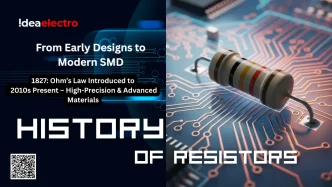Resistors stand as fundamental components in electronics, crucial for controlling electrical current flow within circuits. Their evolution mirrors the broader advancement of electrical and electronic engineering, transforming from rudimentary devices to highly specialized components. The development of resistor technology has consistently followed technological expansion, adapting to demands for greater miniaturization, efficiency, and cost-effectiveness in electronic circuit design. From early experimental apparatus to today’s microscopic surface-mount devices, resistors have played a pivotal role in enabling the sophisticated electronics that define modern life. This journey through resistor history reveals how scientific discovery and engineering innovation have intertwined to create the components we rely on today.

1827: Ohm’s Law Introduced
In 1827, German physicist Georg Simon Ohm published the fundamental law that defines electrical resistance, now known as Ohm’s Law. This principle established the direct relationship between voltage, current, and resistance, forming the mathematical base that allowed engineers and scientists to calculate and design electrical circuits with precision. Although resistors as components had not yet been physically developed, Ohm’s Law became the theoretical foundation that made controlled resistance in circuit both measurable and meaningful. Modern resistor design, standards, and testing are all rooted in this early discovery.
Late 1800s: First Practical Resistors
Toward the end of the 19th century, the first practical resistors emerged as electricity began to be used for telegraphy, early lighting systems, and scientific equipment. These early resistors were often simple coils of resistance wire used to limit current or adjust signal strength over long communication lines. Resistance boxes with manually selectable values were also developed for laboratory work. Although crude compared to modern components, these early designs marked the beginning of resistors as defined electrical components rather than theoretical concepts.
1900–1920: Carbon Composition Resistors Introduced
With the rise of widespread electrification and early consumer electronics, carbon composition resistors became the first mass-produced resistor type. Made from compressed carbon granules mixed with a binding material, they were inexpensive, easy to manufacture, and available in a wide range of resistance values. These resistors were used in radios, meters, telephony, and early power electronics. Although they had relatively high noise and tolerance variations, their simplicity and scalability made them the first dominant resistor technology of the industrial era.
1920s: Wire-Wound Resistors Commercialized
During the 1920s, the wire-wound resistor was introduced for applications requiring high power handling and precision. Made from resistive wire such as nichrome wound around a ceramic or mica core, they provided better stability and lower noise compared to carbon resistors. Wire-wound resistors were ideal for industrial controls, heaters, large electrical equipment, and metering instruments. Their longevity and thermal resilience meant they remained in widespread use even as new materials and manufacturing technologies developed in later decades.
1930s: Standardized Resistor Color Code Created
As electronic equipment grew more complex, identifying resistor values visually became essential. In the 1930s, the Electronic Industries Association introduced the color band marking system that assigned numeric values to resistor bands, allowing engineers and technicians to quickly read resistance values without charts or labels. This standardization greatly simplified manufacturing, troubleshooting, and assembly. Remarkably, despite its age, the resistor color code system remains one of the most widely recognized component identification methods in the world today.
1950s: Carbon Film Resistors Appear
In the 1950s, carbon film resistors emerged as an improvement over carbon composition designs. These components were made by depositing a thin layer of carbon onto insulated rods and then trimming the film to achieve the desired resistance value. This manufacturing approach provided better tolerance, lower noise, and improved performance over a wide temperature range. Carbon film resistors became common in consumer electronics such as radios, televisions, and household appliances, helping electronics grow more reliable and affordable.
1960s: Metal Film and Metal Oxide Resistors Developed
The 1960s introduced metal film and metal oxide resistors, which brought a significant leap in precision and stability. These resistors offered tighter tolerance ratings, extremely low noise, and better long-term reliability compared to earlier types. Metal film resistors were used in high-fidelity audio systems, measuring instruments, and communication equipment, where accuracy was critical. Metal oxide types also provided superior heat handling, making them suitable for higher power environments. These technologies played a major role in advancing professional and industrial electronics.
1970s: Thick Film and Thin Film Technologies
Resistor technology advanced again in the 1970s with the development of thick film and thin film manufacturing processes. Thick film resistors used screen-printable pastes to apply resistive materials onto ceramic substrates, allowing faster and cheaper production. Thin film resistors, produced using vacuum deposition, offered extremely high precision for demanding applications. These methods supported smaller, more consistent components, enabling higher circuit density and opening the door to the miniaturization trends that would dominate coming decades.
1980s: Surface Mount Resistors Introduced
The shift from manual assembly to automated electronic manufacturing in the 1980s led to the development of surface mount (SMD) resistors. These compact components could be placed directly onto PCB surfaces by robotic machines, eliminating the need for drilled holes and dramatically speeding up production. Standard SMD sizes like 1206, 0805, and 0603 became common, allowing circuits to shrink in size while maintaining or improving performance. This transition marked a major turning point in electronics manufacturing worldwide.
1990s: SMD Dominates Consumer Electronics
By the 1990s, SMD resistors had become the standard choice for most mass-produced electronic devices. Computers, televisions, audio systems, and communication equipment increasingly used SMD components because they reduced size, cost, and assembly time. Through-hole resistors remained in use mainly for high-power applications and prototyping, but the shift toward compact and automated circuit assembly made SMD the mainstream resistor format. This decade firmly established the manufacturing model that still drives electronics today.
2000s: Ultra-Miniature SMD Resistors
As consumer electronics continued to become smaller and more powerful, resistor sizes also decreased. The 2000s saw the widespread adoption of extremely small packages such as 0402, 0201, and even 01005. These tiny components required advanced equipment for manufacturing, placement, and inspection but enabled modern smartphones, laptops, and handheld devices to pack more functionality into less space. Automated pick-and-place systems and laser trimming ensured precise value control despite the small dimensions.
2010s–Present – High-Precision & Advanced Materials
Resistor technology today focuses on achieving exceptional accuracy, thermal stability, and long service life even in extreme environments. Modern manufacturing allows laser trimming, multi-layer thin films, metal foils, and materials engineered for ultra-low temperature coefficients. These resistors are used in aerospace, automotive electronics, medical systems, industrial automation, and high-frequency digital devices. As circuits continue to decrease in size and increase in complexity, resistors remain essential components, evolving alongside the rapidly advancing electronics industry.








